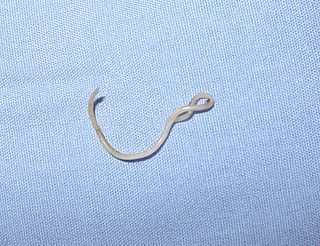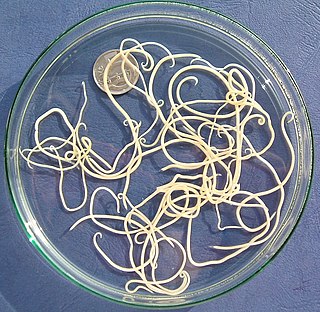
Ascaris lumbricoides is a large parasitic roundworm of the genus Ascaris. It is the most common parasitic worm in humans. An estimated 807 million–1.2 billion people are infected with A. lumbricoides worldwide. People living in tropical and subtropical countries are at greater risk of infection. Infection by Ascaris lumbricoides is known as ascariasis.

Trichuris trichiura, Trichocephalus trichiuris or whipworm, is a parasitic roundworm that causes trichuriasis when it infects a human large intestine. It is commonly known as the whipworm which refers to the shape of the worm; it looks like a whip with wider "handles" at the posterior end. The helminth is also known to cause rectal prolapse.

Trichuriasis, also known as whipworm infection, is an infection by the parasitic worm Trichuris trichiura (whipworm). If infection is only with a few worms, there are often no symptoms. In those who are infected with many worms, there may be abdominal pain, fatigue and diarrhea. The diarrhea sometimes contains blood. Infections in children may cause poor intellectual and physical development. Low red blood cell levels may occur due to loss of blood.

Hymenolepiasis is infestation by one of two species of tapeworm: Hymenolepis nana or H. diminuta. Alternative names are dwarf tapeworm infection and rat tapeworm infection. The disease is a type of helminthiasis which is classified as a neglected tropical disease.

Necator americanus is a species of hookworm commonly known as the New World hookworm. Like other hookworms, it is a member of the phylum Nematoda. It is an obligatory parasitic nematode that lives in the small intestine of human hosts. Necatoriasis—a type of helminthiasis—is the term for the condition of being host to an infestation of a species of Necator. Since N. americanus and Ancylostoma duodenale are the two species of hookworms that most commonly infest humans, they are usually dealt with under the collective heading of "hookworm infection". They differ most obviously in geographical distribution, structure of mouthparts, and relative size.

Taenia saginata, commonly known as the beef tapeworm, is a zoonotic tapeworm belonging to the order Cyclophyllidea and genus Taenia. It is an intestinal parasite in humans causing taeniasis and cysticercosis in cattle. Cattle are the intermediate hosts, where larval development occurs, while humans are definitive hosts harbouring the adult worms. It is found globally and most prevalently where cattle are raised and beef is consumed. It is relatively common in Africa, Europe, Southeast Asia, South Asia, and Latin America. Humans are generally infected as a result of eating raw or undercooked beef which contains the infective larvae, called cysticerci. As hermaphrodites, each body segment called proglottid has complete sets of both male and female reproductive systems. Thus, reproduction is by self-fertilisation. From humans, embryonated eggs, called oncospheres, are released with faeces and are transmitted to cattle through contaminated fodder. Oncospheres develop inside muscle, liver, and lungs of cattle into infective cysticerci.

Parasitic worms, also known as helminths, are large macroparasites; adults can generally be seen with the naked eye. Many are intestinal worms that are soil-transmitted and infect the gastrointestinal tract. Other parasitic worms such as schistosomes reside in blood vessels.

Helminthic therapy, an experimental type of immunotherapy, is the treatment of autoimmune diseases and immune disorders by means of deliberate infestation with a helminth or with the eggs of a helminth. Helminths are parasitic worms such as hookworms, whipworms, and threadworms that have evolved to live within a host organism on which they rely for nutrients. The theory behind helminth therapy is that these worms reduce negative immune responses due to their TH2 immune response that downregulates the abnormal T-cell responses recently associated with autoimmune disorders. This therapy ties to the Hygiene hypothesis in that the lack of exposure to bacteria and parasites such as helminths can cause a weaker immune system leading to being more susceptible to autoimmune disease.

Heligmosomoides polygyrus is a naturally occurring intestinal roundworm of rodents. It belongs to the family Trychostrongylidae, and male and female worms are morphologically distinguishable. The parasite has a direct lifecycle, with its larval form being the infective stage. H. polygyrus has the ability to establish chronic infections in rodents and alter host immune responses. This nematode is widely used as a gastrointestinal parasitic model in immunological, pharmacological, and toxicological studies.

Trichuris, often referred to as whipworms or the silent serpent, is a genus of parasitic helminths from the roundworm family Trichuridae. The name whipworm refers to the shape of the worm; they look like whips with wider "handles" at the posterior end.

Toxocara canis is a worldwide-distributed helminth parasite that primarily infects dogs and other canids, but can also infect other animals including humans. The name is derived from the Greek word "toxon," meaning bow or quiver, and the Latin word "caro," meaning flesh. T. canis live in the small intestine of the definitive host. This parasite is very common in puppies and somewhat less common in adult dogs. In adult dogs, infection is usually asymptomatic but may be characterized by diarrhea. By contrast, untreated infection with Toxocara canis can be fatal in puppies, causing diarrhea, vomiting, pneumonia, enlarged abdomen, flatulence, poor growth rate, and other complications.

Trichuris suis is a whipworm; the variations in thickness of the anterior and posterior segments give the parasite the characteristic "whip-like" appearance. Adult females measure 6 to 8 cm and adult males 3 to 4 cm. T. suis eggs are oval and yellow-brown with bipolar plugs. T. suis is also used in helminthic therapy studies.

Toxascaris leonina is a common parasitic roundworm found in dogs, cats, foxes, and related host species. T. leonina is an ascarid nematode, a worldwide distributed helminth parasite which is in a division of eukaryotic parasites that, unlike external parasites such as lice and fleas, live inside their host. The definitive hosts of T. leonina include canids and felines (cats), while the intermediate hosts are usually rodents, such as mice or rats. Infection occurs in the definitive host when the animal eats an infected rodent. While T. leonina can occur in either dogs or cats, it is far more frequent in cats.

Capillaria hepatica is a parasitic nematode which causes hepatic capillariasis in rodents and numerous other mammal species, including humans. The life cycle of C. hepatica may be completed in a single host species. However, the eggs, which are laid in the liver, must mature outside of the host body prior to infecting a new host. Death and decomposition of the host in which the adults reach sexual maturity are necessary for completion of the life cycle.

Nippostrongylus brasiliensis is a gastrointestinal roundworm that infects rodents, primarily rats. This worm is a widely studied parasite due to its simple lifecycle and its ability to be used in animal models. Its lifecycle is similar to the human hookworms Necator americanus and Ancylostoma duodenale, taking five molting stages to become sexually mature.

Trichuris vulpis is a whipworm that lives in the large intestine of canines in its adult stages. Out of different types of worms, Trichuris vulpis is one of the smaller worms with a size ranging from 30–50 mm in length. As the name suggests, the worm has a whip-like shape with distinct features including a small, narrow anterior head, which is the digestive part of the worm, and a larger posterior tail, which is the reproductive part of the worm. Eggs from T. vulpis are oval shaped with bipolar plugs and contain a thick outer shell. Their sizes range from 72–90 μm in length and 32–40 μm in width. Because of their thick outer shell, T. vulpis eggs are very resistant to environmental extremes such as freezing or hot temperatures, thus allowing for their long viability in the outside world.

Parascaris equorum is a species of ascarid that is the equine roundworm. Amongst horse owners, the parasites are colloquially called "Ascarids". This is a host-specific helminth intestinal parasite that can infect horses, donkeys, and zebras. Horses up to six months of age are the most susceptible to infection. After this time, infection rates begin to decline and is extremely uncommon in horses over twelve months of age. It cannot infect humans or other animals. It is yellow-white in color, and females can become as large as 15 inches (38 cm) in length. Found worldwide, P. equorum is one of the most difficult equine parasites to kill, requiring larger doses of more powerful anthelmintic medications than are needed for other equine parasites.

Cooperia oncophora is one of the most common intestinal parasitic nematodes in cattle in temperate regions. Infections with C. oncophora may result in mild clinical symptoms, but can lead to weight loss and damage of the small intestine, especially when co-infections with other nematodes such as O. ostertagi occur. Infections are usually treated with broad-spectrum anthelmintics such as benzimidazole, but resistance to these drugs has developed in the last decades and is now very common. C. oncophora has a direct life cycle. Infective larvae are ingested by the host. The larvae grow to adults, which reproduce in the small intestines. Eggs are shed onto the pasture with the faeces, which leads to new infections. Co-infections with other gastro-intestinal nematodes such as O. ostertagi and H. contortus are common.
Pterygodermatites peromysci is an intestinal parasitic nematode in the genus Pterygodermatites of the family Rictulariidae.

Nematode infection in dogs - the infection of dogs with parasitic nemamotodes - are, along with tapeworm infections and infections with protozoa, frequent parasitoses in veterinary practice. Nematodes, as so-called endoparasites, colonize various internal organs - most of them the digestive tract - and the skin. To date, about 30 different species of nematode have been identified in domestic dogs; they are essentially also found in wild dog species. However, the majority of them often cause no or only minor symptoms of disease in adult animals. The infection therefore does not necessarily have to manifest itself in a worm disease (helminthosis). For most nematodes, an infection can be detected by examining the feces for eggs or larvae. Roundworm infection in dogs and the hookworm in dogs is of particular health significance in Central Europe, as they can also be transmitted to humans (zoonosis). Regular deworming can significantly reduce the frequency of infection and thus the risk of infection for humans and dogs.
















